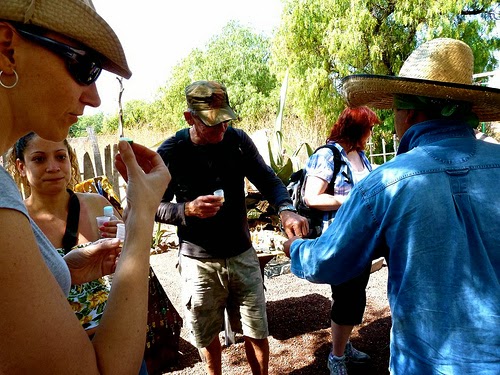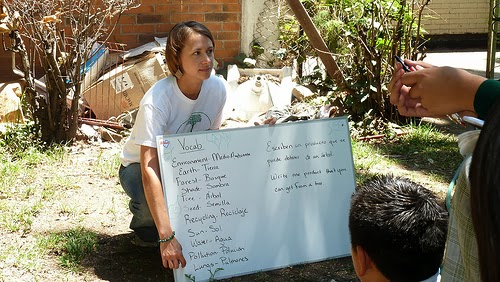 |
| Don’t be a cookie-cutter tourist; spice up your trip with some Spanish Photo credit: Carlos Van Vegas licensed CC BY 2.0 |
1. Take some classes before you go
You will make things a whole lot easier and more enjoyable for yourself by brushing up on your language skills before arriving in a Spanish-speaking country. You will quite literally put your brain to work from the moment you arrive–navigating the airport, talking to customs officers, and finding your way to a taxi or other transportation. Even if you still consider yourself a novice at Spanish (if you’re not sure test your level here), you’ll feel more comfortable and will be able to get around more confidently if you recently took some classes. And no, you don’t necessarily have to spend an arm and a leg at language schools. Hooked up to the Internet, you can devour an ungodly number of Spanish language tutorials in every shape and size without spending a dime. There are resources all around you. Youtube, blogs, podcasts, free ebooks...you name it!
2. Hang with the locals
If you’re going to any decent-sized city in South America, you may be surprised at how easy it is to find a chain restaurant you recognize, a coffee shop that looks just like your favorite one back home, and a group of foreigners speaking English. If you’re like most travelers, you’ll be tempted to visit those places and spend your time with the English-speakers. Avoid the comfort of what you know and branch out to where the locals are instead. Grab a seat on an open bench in the Plaza de Armas, or on the steps of the main Cathedral. If you’re walking around looking for a place for dinner, choose the restaurant (or hole in the wall) that’s filled with locals, not tourists. That’s where the action is. What’s the point of spending a bomb travelling thousands of miles to an exotic foreign destination and yet seek everything as it used to be back home! If you just aren’t willing to mingle with the locals, you might as well stay home, warm and cozy, and save your precious dollars.
3. Volunteer your time
 |
| Volunteer programs help your Spanish in more ways than you ever realized Photo credit: Trees For The Future licensed CC BY 2.0 |
Imagine a gringo in Mexico, sporting a sombrero and a pair of binos and a point-and-shoot happily trotting around with a bunch of others like him in a tour van with an English-speaking guide on a cookie-cutter package tour. Then imagine a solo traveller losing his way someplace in rural Chiapas giving a little English lesson at a local elementary school, celebrating the Day of the Dead at the village church, and hitching a ride to the nearby flea market with a bunch of villagers to dicker over a pair of huaraches. Which one of the two had a richer experience? Which one of the two would you be more excited to listen to when both are talking about their trips?
4. Take a tour...in Spanish
Few vacations are complete without at least one or two tours. And if you’re going to take a tour, why not use it as an opportunity to practice your Spanish? If you feel that your skills aren’t advanced enough for this exercise, try a lower-risk version of it, so to speak. Go to an art museum and get the audio guide in Spanish. Many of these are free or cost a nominal fee, so you won’t have to make a big financial investment or miss out on an English-led tour at an attraction you’re especially excited to learn about. Nothing shouts “gringo” more than a bunch of blissfully clueless men and women (again with cheap sombreros and floral-print shirts to complete the look) huddled around an English-speaking tour guide. You must step out of your comfort zone if you intend to acquire any skill. Refusing to face Spanish in the real world when you are lucky enough to land the opportunity is not such a good idea if you’re looking to learn it.
5. Visit an art gallery or museum
When visiting one of these places, give yourself plenty of time to enjoy it. If there’s a brochure about one of the exhibits, read through it. Take the time to move from piece to piece, reading the signage and individual descriptions throughout the collections. Pull out your Spanish dictionary and move at a leisurely pace. If there are placards in English and Spanish, work hard to read them in Spanish first, understand the descriptions, then read the English to confirm you’re on the right track. Art galleries and museums can shed light on where a nation or group of people has been or where they’re going. You can learn about the history of indigenous people, how religion has affected their culture, what contemporary artists are saying, and more, depending on the type of establishment you visit. Many Latin American countries have kid-friendly museums too, so children can learn and play at the same time. No language acquisition program is complete without a proper understanding of and appreciation for the culture that the language represents. No cultural exploration is complete without at least a working knowledge of its history. And no cultural pursuit is complete without a visit to a good museum. Latin America has many. Do not skip them even if museums generally bore you.
6. Take things slow
The number one thing that can set your Spanish-learning efforts off course during your South American vacation is moving too fast. If you sit down to order lunch at a restaurant and just point to something on the menu, you’ve just lost a chance to practice your reading, listening, and speaking skills. Try moving at a slower pace, instead. In this lunchtime scenario, arrive at the restaurant and start studying the menu. Order a drink first, then ask the server if they recommend something for lunch. Ask about their specials or what dishes are most popular. After placing your order, keep the menu and continue reading it. Listen to the people around you. Not only will you be practicing your Spanish, but you’ll be learning more about the culture and the local way of life.
Dusty is a full-time freelance writer who contributes to the Listen & Learn network. She is a world traveler who especially loves Latin American culture and food.



.png)